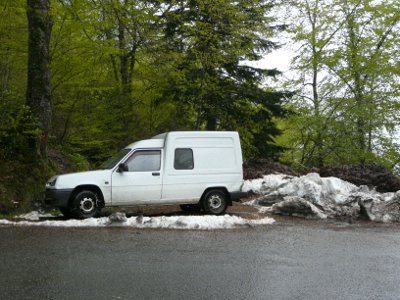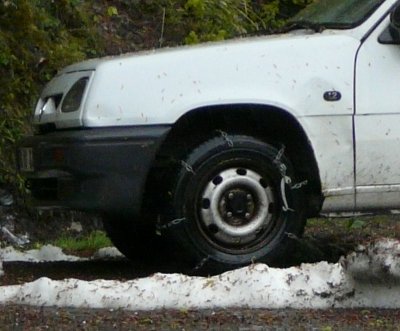Snow Chains – Should Your Motorhome Have A Set?
On holiday in France recently I saw this van parked at the side of a mountain road in the Pyrenees:

On closer inspection, it’s possible to see that his front (drive) wheels are wrapped in a set of snow chains:

It’s clear from the top photo that the road surface was clear of snow – but I can tell you that there was still a lot of the white stuff around at both sides of the road and it rapidly got worse a little further up – until the road was closed.
Snow chains shouldn’t be used on cleared, surfaced roads but it obviously hadn’t been that long since this road was well covered and only passable by vehicles – like this one – with chains. So should you carry snow chains in your motorhome if you plan to visit snowy countries or mountainous areas in winter?
What Are Snow Chains?
Snow chains are metal chains that can be fitted around your drive wheels to give you extra traction, as visible in the picture above.
The chains form bars across the width of your tyres that bite into compacted snow and ice and give you traction where you would otherwise have none.They can be fitted without removing the wheels but are often reckoned to be a bit of a pain to fit – certainly it is a good idea to learn how to fit them at home on a warm summer’s day, rather than by the side of the road in freezing temperatures and heavy snow.
Do I Need Snow Chains?
In the UK, almost certainly not.
For winter driving in Europe, perhaps. It depends where you are planning to go.
Snow chains are an (almost) essential accessory for anyone who drives in the Alps or Pyrenees in winter and they are often either strongly recommended or legally required by road laws in these regions. In both the Alps and Pyrenees, there are signs by the side of the road telling you whether snow chains must be carried or not.
Fine. But what about for more moderate use – countries with lots of snow in non-mountainous areas? Again, different countries have different rules and some require you to carry snow chains at certain times of year, in case you need them.
(For an excellent and trustworthy guide to driving laws in all European countries, visit the AA’s European Driving Guide)
The Secret Is Winter Tyres
While carrying snow chains may be advised, the real secret lies in those black rubber things you use all the time – your motorhome’s tyres. Most UK vehicles, including motorhomes, come with summer tyres as standard. For the vast majority of drivers in the UK, summer tyres are the only type of tyres ever used, even in winter.
The truth is that summer tyres aren’t really that suitable for winter use, but you can get away with it unless it snows. That’s one reason why the UK grinds to a halt with a couple of inches of snow but European countries such as Austria, Germany and Poland don’t. In European countries where severe winters with lots of snow are usual, most drivers fit winter tyres to their vehicles in the autumn and use those until spring arrives.
In a number of European countries, winter tyres are a legal requirement during some months of the year and failure to comply can mean a fine (especially if it results in you causing an accident or obstruction). Again – check the AA’s European Driving website for full country-by-country details.
Winter tyres have two main benefits that make them more suitable for use in cold weather:
- They have a slightly softer compound that remains softer and more flexible when it gets very cold, improving grip in slippery conditions. Summer tyres become very hard and stiff at low temperatures, reducing their grip.
- Winter tyres tend to have a slightly deeper, blockier tread that grips snow more effectively, rather than just slipping over it
Summer tyres are proven to be less effective than winter tyres when the temperature falls below around 7 degrees Celsius, even without snow. In a motorhome, you can make a strong case for running winter tyres all year round; motorhome mileages tend to be low and ultimate driving performance isn’t important, so slightly increased tyre wear isn’t an issue.
Having winter tyres can be more useful than 4-wheel drive in snowy conditions – last winter saw plenty of modern ‘soft-roader’ 4x4s getting stuck in the snow because their wheels were shod with standard summer road tyres.
On the other hand, I read the other day that drivers participating in the long-term trials of the Mini E (a new electric version of the Mini) were all given winter tyres to use during the winter and reported that, in snow, it made the cars handle “like 4x4s”. This just highlights how much difference the right tyres can make – the Minis were just regular, front-wheel drive road cars.
In normal snowy conditions where roads are regularly cleared, a standard two-wheel drive car or van with winter tyres will cope fine most of the time – only in more extreme conditions are chains required.
It’s up to you to research the countries you are visiting and work out what is required to keep you safe and legal – although you might get away with it, you might not, and the consequences could be far worse than a fine.
